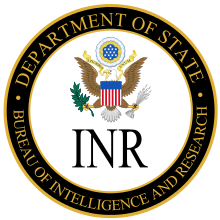Bureau of Intelligence and Research
Bureau of Intelligence and Research (INR, Biuro Wywiadu i Badań) – biuro Departamentu Stanu USA ds. wywiadu, analiz i prognoz politycznych, stanowi jego wewnętrzną komórkę. Kierowane jest przez dyrektora w randze podsekretarza stanu. Materiały dostarczane przez INR mają zazwyczaj charakter analizy bieżącej sytuacji na świecie, przeznaczonej na potrzeby Departamentu Stanu, niż tradycyjnych danych wywiadowczych.
Statut biura nakłada na nie zadania koordynacji badań przeznaczonych dla Departamentu Stanu, a nie prezydenta USA, co ogranicza jego kompetencje do gromadzenia potwierdzonych danych wywiadu zagranicznego, mających związek z kształtowaniem i realizacją polityki zagranicznej Stanów Zjednoczonych.
Utworzone we wrześniu 1945 roku przez prezydenta Harry’ego Trumana biuro zatrudniało początkowo oficerów wywiadu i analityków z Biura Służb Strategicznych (Office of Strategic Services, OSS). W początkowym okresie działalności biura sądzono, że przejmie ono po OSS rolę głównej agencji wywiadowczej Stanów Zjednoczonych. Jednak w trakcie reorganizacji amerykańskiego wywiadu prezydent Truman postanowił utworzyć agencję niezależną od administracji federalnej. Przyczyniło się to do utworzenia CIA i tym samym do umniejszenia roli INR.
Bibliografia
- Polmar N., Allen T.B., Księga szpiegów. Encyklopedia. Wyd. Magnum, Warszawa 2000.
Linki zewnętrzne
Media użyte na tej stronie
Seal of the United States Department of Justice.
The origins of the seal are unknown; it was first used in the 19th century as the seal for the Office of the Attorney General (prior to the formation of the Department of Justice) but the exact date is unknown. Even the translation of the Latin motto is murky, a matter of debate between Latin scholars. The Department's currently accepted translation is who prosecutes on behalf of Lady Justice, referring to the Attorney General. The motto is an allusion to the wording of the writ in a qui tam action: qui tam pro domino rege quam pro se ipso sequitur ("he who sues on behalf of our lord the King as well as for himself." The current-day seal dates from 1934, when some (though not all) of the heraldic mistakes on the original were corrected. More information here.Seal of the United States Department of Homeland Security. A graphically styled American eagle appears in a circular blue field. The eagle's outstretched wings break through an inner red ring into an outer white ring that contains a circular placement of the words "U.S. DEPARTMENT OF" in the top half and "HOMELAND SECURITY" in the bottom half. The outer white ring has a silvery gray border. As in The Great Seal, the eagle’s left claw holds an olive branch with 13 leaves and 13 seeds while the right claw grasps 13 arrows. Centered on the eagle's breast is a shield divided into three sections containing elements that represent the homeland "from sea to shining sea." The top element, a dark blue sky, contains 22 stars representing the original 22 agencies and bureaus that have come together to form the department. The left shield element contains white mountains behind a green plain underneath a light blue sky. The right shield element contains four wave shapes representing the oceans, lakes and waterways alternating light and dark blue separated by white lines.
Seal of the United States Department of Justice.
The origins of the seal are unknown; it was first used in the 19th century as the seal for the Office of the Attorney General (prior to the formation of the Department of Justice) but the exact date is unknown. Even the translation of the Latin motto is murky, a matter of debate between Latin scholars. The Department's currently accepted translation is who prosecutes on behalf of Lady Justice, referring to the Attorney General. The motto is an allusion to the wording of the writ in a qui tam action: qui tam pro domino rege quam pro se ipso sequitur ("he who sues on behalf of our lord the King as well as for himself." The current-day seal dates from 1934, when some (though not all) of the heraldic mistakes on the original were corrected. More information here.Old version of the seal of the United States Department of the Treasury, prior to the design being simplified in 1968.
According to Treasury records, the original seal was probably designed in 1778 by Francis Hopkinson for the Board of Treasury during the period of the Articles of Confederation, meaning the seal predates the Federal Government and the Department of the Treasury itself. The earliest documented usage of the seal was in 1782. The Treasury seal has been printed on U.S. paper currency since 1862.
The Latin inscription is an abbreviation for the phrase Thesauri Americae Septentrionalis Sigillum, which means "The Seal of the Treasury of North America." The arms depicts balancing scales (to represent justice), a key (the emblem of official authority) and a chevron with thirteen stars (to represent the original states).
The design of the seal was simplified in 1968; the major elements remained but the Latin inscription was replaced by "Department of the Treasury", and the year of the Department of the Treasury's creation (1789) was added to the bottom. Paper money started using the new design with the 1969 series of bills.
For more information, see here, here, and here.Seal of the United States Department of State. It is mostly composed of the Great Seal of the United States.












